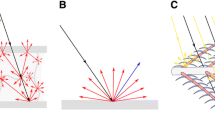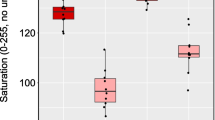Abstract
Plumage colour has always been a major criterion when describing and distinguishing bird taxa. Today, the use of reflection spectrophotometry is the most commonly used technique to study plumage coloration. A major advantage of this method is the opportunity of observing reflection beyond the human colour vision range—including the UV-waveband. Traditional taxonomic and phylogenetic research is often based on bird skins held in collections in natural history museums worldwide. Different agents for preservation have been used to prevent skins from being damaged by arthropod pests. Sometimes, parts of the plumage have been contaminated with stains from preservation agents. When dried, they are almost invisible to the human eye under normal sunlight conditions and cause no obvious change to feather coloration. However, some preservation agents contain fluorescent components which show up brightly when illuminated with UV-light. Furthermore, undetectable to the human eye, stains from these agents annihilate UV-reflection, preventing accurate data collection based on the UV-reflection of bird feathers. Measuring plumage parts which have been accidentally stained will lead to a relative underestimate of UV-reflection. In studying 20,000 samples, we found fluorescent stains in some 300 bird skins of varying ages (1913–2004) in museum collections throughout Europe and the USA. Different preservation agents have been evaluated for their fluorescence properties.


Similar content being viewed by others
References
Andersson S, Örnborg J, Andersson M (1998) Ultraviolet sexual dimorphism and assortative mating in blue tits. Proc R Soc Lond B 265:445–450
Arnold EK, Owens IPF, Marshall NJ (2002) Fluorescent signalling in parrots. Science 295:92
Bennett ATD, Cuthill IC, Partridge JC, Lunau K (1997) Ultraviolet plumage colors predict mate preferences in starlings. Proc Natl Acad Sci USA 94:8618–8621
Boles WE (1990) Glowing parrots—need for a study of hidden colours. Birds Int 3:76–79
Burkhardt D (1989) UV vision: a bird’s eye view of feathers. J Comp Physiol A 164:787–796
Church SC, Bennett ATD, Cuthill IC, Partridge JC (1998) Ultraviolet cues affect the foraging behaviour of blue tits. Proc R Soc Lond B 265:1509–1514
Cuthill IC, Partridge JC, Bennett ATD, Church SC, Hart NS, Hunt S (2000) Ultraviolet vision in birds. Adv Stud Behav 29:159–214
Endler JA, Théry M (1996) Interacting effects of lek placement, display behavior, ambient light, and color patterns in three neotropical forest-dwelling birds. Am Nat 148:421–452
Goldberg L (1996) A history of pest control measures in the anthropology collections, National Museum of Natural History, Smithsonian Institution. J Am Inst Conserv 35:23–43
Hausmann F, Arnold KE, Marshall NJ, Owens IPF (2002) Ultraviolet signals in birds are special. Proc R Soc Lond B 270:61–67
Hawks CA, Von Endt DW (1990) Mercury and mercury compounds in natural history collections: an annotated bibliography. Nat Hist Conserv 5:4–19
Hawks CA, Williams SL (1986) Arsenic in natural history collections. Leather Conserv News 2:1–4
Huth H-H, Burkhardt D (1972) Der spektrale Sehbereich eines Violettohr-Kolibris. Naturwissenschaften 59:650
Maier EJ (1993) To deal with the “invisible”: on the biological significance of ultraviolet sensitivity in birds. Naturwissenschaften 80:476–478
Pearn SM, Bennett ATD, Cuthill IC (2001) Ultraviolet vision, fluorescence and mate choice in a parrot, the budgerigar Melopsittacus undulatus. Proc R Soc Lond B 268:2273–2279
Acknowledgements
The authors would like to sincerely thank K.-L. Schuchmann for his creative advice and his support. We would also like to thank Joel L. Cracraft, Paul R. Sweet, Shannon Kenney and Peter Capainolo from the American Museum of Natural History in New York and Nate Rice and Leo Joseph from the Academy of Natural Sciences in Philadelphia and Peter Jones from the Natural History Museum in Tring, UK, for their support and for allowing access to the collections. We are also grateful to Alexander Mullen and Frank Steinheimer for their critical review of the manuscript. This study was made possible by grants from the Heinrich Hertz Foundation of the State Department of Science and Research of North Rhine-Westphalia, Germany and the Collection Study Grant of the American Museum of Natural History.
Author information
Authors and Affiliations
Corresponding author
Additional information
Communicated by F. Bairlein
Rights and permissions
About this article
Cite this article
Pohland, G., Mullen, P. Preservation agents influence UV-coloration of plumage in museum bird skins. J Ornithol 147, 464–467 (2006). https://doi.org/10.1007/s10336-005-0038-0
Received:
Revised:
Accepted:
Published:
Issue Date:
DOI: https://doi.org/10.1007/s10336-005-0038-0




